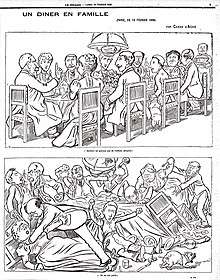Caran d'Ache
Caran d'Ache was the pseudonym of the 19th century French satirist and political cartoonist Emmanuel Poiré (6 November 1858 – 25 February 1909).[1] The pseudonym comes from Russian: карандаш, romanized: karandash meaning "pencil". While his first work glorified the Napoleonic era, he went on to create "stories without words" and as a contributor to newspapers such as the Le Figaro, he is sometimes hailed as one of the precursors of comic strips. The Swiss art products company Caran d'Ache is named after him.[2]
| Caran d'Ache | |
|---|---|
 Photographed 1890 by Atelier Nadar | |
| Born | Emmanuel Poiré 6 November 1858 Moscow, Russian Empire |
| Died | 25 February 1909 (aged 50) Paris, France |
| Nationality | French |
Biography
Born in Moscow, 6 November 1858, he was the grandson of an Officer-Grenadier in Napoleon's Grande Armée who, wounded during the Battle of Borodino, had stayed behind in Russia.[3] After his grandfather's death he was adopted by a Polish family whose daughter he later married.
In 1877 Caran d'Ache emigrated to France where he took French citizenship and joined the Army[3] for five years where he was assigned to design uniforms for the ministry of war and where he also contributed to their journal, La Vie militaire, with satirical illustrations, among them some caricatures of the German army.[1]
In 1898 he co-founded the satirical, anti-Dreyfusard weekly magazine Psst… ! along with fellow artist and designer Jean-Louis Forain. The magazine lasted 85 issues and was made up entirely of editorial cartoons by Caran d'Ache and Forain, caricaturing society and its scandals from an antisemitic, pro-Army viewpoint.[4][5]
He died in Paris on 25 February 1909 at the age of 50.
Works

- 1880: His first drawings of military caricatures were published in La Chronique Parisienne.[6]
- 1892: Caran d'Ache published Carnet de Chèques ("Checkbook") on the Panama Canal Affair.
- 1895: He started publishing editorial cartoons (every Monday) in the daily Le Figaro, and soon thereafter for the popular weekly Le Rire.
- 1898: Caran d'Ache published the cartoon Un diner en famille ("A Family Dinner"), highlighting the intense disagreements in French society regarding the Dreyfus Affair. It appeared a month after Émile Zola's famous J'Accuse, which inflamed and hardened opinion on both sides.[7]
Sources
- Chisholm, Hugh, ed. (1911). . Encyclopædia Britannica (11th ed.). Cambridge University Press.
- Caran d’Ache and the story of the black stone Archived October 29, 2011, at the Wayback Machine
- Graphic Witness. "Le Rire".
- Lambeth, John. "La Caricature pendant la 3e République surtout autour de l'Affaire Dreyfus" [Caricature during the 3rd Republic especially with respect to the Dreyfus Affair]. wlu.edu (in French). Washington & Lee. Archived from the original on June 19, 2002. Retrieved November 23, 2017., quoting from Lethève, Jacques (1961). La caricature et la presse sous la IIIe République [Caricature and the Press in the 3rd Republic]. Kiosque #16 (in French). Paris: Armand Colin. OCLC 801910610.
- Forain, Jean-Louis; d'Ache, Caran (10 December 2012) [1st pub. 1898-1899]. "Psst...!(Paris)". BnF Gallica (in French). Paris: Plon. Retrieved November 23, 2017 – via "Source gallica.bnf.fr/Bibliothèque nationale de France".
- Lambiek Comiclopedia. "Caran d'Ache".
- Marrus, Michael R. (1994). "'En Famille': The Dreyfus Affair and Its Myths". French Politics and Society. Berghahn Books. 12 (4): 77–90. ISSN 0882-1267. JSTOR 42844432.
The point of the cartoon—the volatility of the debate over Dreyfus, its explosive force, its capacity to divide families and by implication an entire country—is one of the most frequently made about the Affair, and one of the reasons why we remember it today, when so many other affaires have been forgotten.
External links
| Wikimedia Commons has media related to Caran d'Ache. |
| Wikisource has the text of the 1911 Encyclopædia Britannica article Caran d'Ache. |
- Caran d'Ache biography on Lambiek Comiclopedia